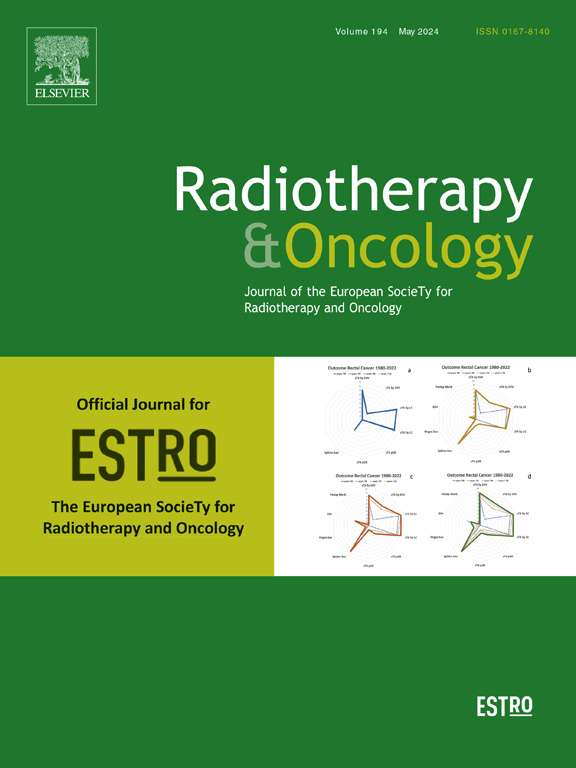Clinical validation of statistical predictive model for patient-specific quality assurance outcomes in stereotactic radiotherapy using secondary Monte Carlo dose calculations
IF 4.9
1区 医学
Q1 ONCOLOGY
引用次数: 0
Abstract
Purpose
To evaluate Monte Carlo (MC) secondary dose verification for predicting ionization chamber (IC)-based patient-specific quality assurance (PSQA) measurements for stereotactic body radiotherapy (SBRT) plans.
Methods
IC-based PSQA is a trusted method for verifying accurate delivery of absolute dose calculated by the treatment planning system (TPS). However, these measurements are often time-consuming and challenging to perform precisely, especially for small-volume SBRT targets. To investigate an MC-based method as a viable alternative, a logistic regression model was developed to predict measurement-based PSQA results utilizing 400 retrospectively collected IC PSQA measurements across our system. Each clinically approved plan was recalculated using a commercially available secondary MC-based dose calculation platform (Rad MonteCarlo, Radformation, NY). The dose to a contoured volume corresponding to the active IC volume was recorded. Additionally, measurement setup uncertainty was modeled by placing equivalent volumes +/- 2 mm in each cardinal direction. The TPS-calculated value was compared to the average MC-simulated values for all contours. Receiver Operating Characteristic (ROC) analysis was performed on an additional dataset of 328 prospective PSQA measurements to determine MC-based QA prediction thresholds for indicating when physical measurements can be safely avoided.
Results
Of the 400 model plans, the percent differences between IC and TPS doses were [Median: −0.06%, Range: −19.6%-4.5%]. The percent differences between IC and MC doses were [Median: 0.17%, Range: −21.8%-5.1%]. When investigating MC against TPS dose for predicting likely PSQA failures, ROC analysis yielded an AUC of 0.76. Based on threshold analysis of the prospective validation dataset, a difference of 1% between MC and TPS calculations resulted in zero false negatives, and would safely reduce the number of required IC measurements by 46%.
Conclusion
This study demonstrates feasibility of and a workflow for implementing MC-based secondary dose calculations to reduce the number of physical measurements required for PSQA without compromising safety and quality.
利用二次蒙特卡罗剂量计算立体定向放疗患者特异性质量保证结果的统计预测模型的临床验证。
目的:评价蒙特卡罗(MC)二次剂量验证在预测立体定向全身放疗(SBRT)计划中基于电离室(IC)的患者特异性质量保证(PSQA)测量中的应用。方法:基于ic的PSQA是一种可靠的方法,可用于验证由治疗计划系统(TPS)计算的绝对剂量的准确递送。然而,这些测量通常是耗时的,并且很难精确执行,特别是对于小体积的SBRT目标。为了研究基于mc的方法作为可行的替代方案,我们开发了一个逻辑回归模型,利用我们系统中回顾性收集的400个IC PSQA测量值来预测基于测量的PSQA结果。每个临床批准的计划都使用市售的二次mc剂量计算平台(Rad MonteCarlo, Radformation, NY)重新计算。记录与活性IC体积相对应的轮廓体积的剂量。此外,通过在每个基本方向上放置等效体积+/- 2 mm来模拟测量设置的不确定度。将tps计算值与所有轮廓的mc模拟平均值进行比较。对328个预期PSQA测量数据的额外数据集进行受试者工作特征(ROC)分析,以确定基于mc的QA预测阈值,以指示何时可以安全避免物理测量。结果:在400个模型计划中,IC和TPS剂量之间的百分比差异为[中位数:-0.06 %,范围:-19.6 %-4.5 %]。IC和MC剂量之间的百分比差异为[中位数:0.17 %,范围:-21.8 %-5.1 %]。当研究MC与TPS剂量预测可能的PSQA失败时,ROC分析得出AUC为0.76。基于前瞻性验证数据集的阈值分析,MC和TPS计算之间的差异1 %导致零假阴性,并且可以安全地减少所需IC测量的数量46 %。结论:本研究证明了实施基于mc的二次剂量计算的可行性和工作流程,以减少PSQA所需的物理测量次数,同时不影响安全性和质量。
本文章由计算机程序翻译,如有差异,请以英文原文为准。
求助全文
约1分钟内获得全文
求助全文
来源期刊

Radiotherapy and Oncology
医学-核医学
CiteScore
10.30
自引率
10.50%
发文量
2445
审稿时长
45 days
期刊介绍:
Radiotherapy and Oncology publishes papers describing original research as well as review articles. It covers areas of interest relating to radiation oncology. This includes: clinical radiotherapy, combined modality treatment, translational studies, epidemiological outcomes, imaging, dosimetry, and radiation therapy planning, experimental work in radiobiology, chemobiology, hyperthermia and tumour biology, as well as data science in radiation oncology and physics aspects relevant to oncology.Papers on more general aspects of interest to the radiation oncologist including chemotherapy, surgery and immunology are also published.
 求助内容:
求助内容: 应助结果提醒方式:
应助结果提醒方式:


